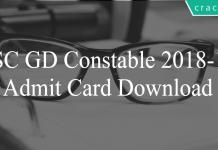SSC CGL Questions on Mughal Empire
Download SSC CGL Mughal Empire questions with answers PDF based on previous papers very useful for SSC CGL exams. 20 Very important Mughal Empire objective questions for SSC exams.
Download SSC CGL Questions on Mughal Empire
Instructions
Rearrange the parts of the sentence in correct order.
Question 1: P: The Mughal empire was extensive, but it was not integrated.
Q: It was rather an agglomeration of territories bound together by a common administration and common ties to the imperial authority.
R: The strong hand of the emperor held the country together, compelling obedience from the nobles who governed the provinces.
S: But these nobles felt no sense of national loyalty, for the simple reason that the empire was not a nation.
a) PRQS
b) SRQP
c) PRSQ
d) RSQP
Question 2: Which battle has led to the foundation of Mughal empire?
a) 2nd Battle of Panipat
b) 1st Battle of Panipat
c) 3rd Battle of Panipat
d) Battle of Kannauj
Question 3: ….. was the Finance Minister of the Mughal empire during Akbar’s reign.
a) Birbal
b) Raja Man Singh 1
c) Tansen
d) Raja Todar Mal
Question 4: At the time of the death of Aurangzeb in 1707, the Mughal Empire consisted of how many Subahs?
a) 21
b) 17
c) 20
d) 14
Question 5: The Mughal empire was founded by
a) Babur
b) Humayun
c) Akbar
d) Shah Jahan
Question 6: Which Mughal ruler transferred the capital of Mughal empire from Agra to Delhi permanently?
a) Humayun
b) Aurangzeb
c) Babar
d) Shah Jahan
Question 7: Who was the founder of the Mughal empire?
a) Akbar
b) Humayun
c) Babur
d) Alauddin Khilji
Question 8: What was the northwestern border of the Mughal Empire during the reign of
Akbar?
a) Punjab
b) Hindukush
c) Kabul
d) Sindh
Question 9: The foundation of Mughal empire is laid by which of the following rulers after defeating Ibrahim Lodi that marked the end of Lodhi Dynasty?
a) Aurangazeb
b) Jahangir
c) Akbar
d) Babur
Question 10: The foundation of Mughal empire is laid by which of the following rulers after defeating Ibrahim Lodi that marked the end of Lodhi Dynasty?
a) Aurangazeb
b) Jahangir
c) Akbar
d) Babur
18000+ Questions – Free SSC Study Material
Instructions
The greatest flourishing of northern Indian culture, art, and imperial strength undoubtedly took place during the reign of the Mughal monarchs of the 16th and 17th centuries. The Mughals were Central Asian descendents of the great Mongol warriors Ghengis Khan and Timur (Tamerlane), whose hordes of cavalry swept across the Eurasian steppe in the 13th and 14th centuries, conquering everything between Beijing and Budapest. But by the turn of the 16th century, the great Mongol empire has splintered: the many royal descendents of Ghengis and Timur fought over the territorial scraps and did their best to hold’ on to their own minor Sultanates.
One of these Sultans. Babur, was not satisfied with his small kingdom of Ferghana (now in modern-day Kyrgyzstan and eastern Uzbekistan), and he tried and tried again to permanently reconquer Timur’s greatest prize, Samarkand. He never succeeded. So instead, Babur turned his attention south to the Sultanate of Delhi in northern India. which had been ruled successively by five dynasties of Muslim warriors from Afghanistan since the late It century. As history would show, Babur’s campaign against the Delhi Sultanate catalyzed the foundation of one of the greatest dynasties in the history of South Asia : the Mughal Empire.
Question 11: the word closet in meaning to catalyzed is
a) unrestricted
b) exploited
c) disseminated
d) accelerated
Question 12: the mmongols in the 13th and 14th centuries
a) plundered the greater part of asia and eastern europe
b) gave rise to the mughal dynasty
c) encouraged imperial strength in northern india
d) none of the above
Question 13: the mughal rulers were responsible for
a) unleashing terror amongst their subjects
b) organizing the eurasian stepe region
c) patronizing art and culture
d) in-fighting amongst themselves
Question 14: The mughal attacked the delhi sultanate because
a) they were the royal descendants of ghengis khan
b) they wanted to expand their kingdom
c) they could not gain suprremacy in the kingdom of samarkand
d) both (B) and (C)
Question 15: The mughals can trace their ancestry to
a) beijing
b) budapest
c) central asia
d) the eurasian steppes
Question 16: Improve the bracketed part of the sentence.
If a person (studied) the history of the Maratha empire, he would have wondered how a small warrior tribe could have challenged the mighty Mughals.
a) has studied
b) had studied
c) could study
d) no improvement
Question 17: Whose reign in Indian History is called the Golden Age of India?
a) Mughal Empire
b) Maratha Empire
c) Gupta Empire
d) Maurya Empire
Question 18: Which empire’s time period is regarded as the Golden Age of India?
a) Maurya
b) Mughal
c) Gupta
d) Chola
Question 19: During Akbar’s reign who was the Finance Minister of the Mughal empire?
a) Raja Todar Mal
b) Man Singh I
c) Birbal
d) Tansen
Question 20: Which religion was propounded by Mughal Emperor Akbar in 1582 A.D., with the intention of merging the best elements of different religions?
a) Akbarnama
b) Ain-i-Akbari
c) Zij-i-Ilkhani
d) Din-e-Ilahi
100+ Free GK Tests for SSC Exams
Answers & Solutions:
1) Answer (C)
2) Answer (B)
3) Answer (D)
4) Answer (A)
5) Answer (A)
6) Answer (D)
Shah Jahan transferred the capital of Mughal empire from Agra to Delhi permanently in 1658.
=> Ans – (D)
7) Answer (C)
8) Answer (B)
9) Answer (D)
10) Answer (D)
11) Answer (D)
12) Answer (B)
13) Answer (B)
14) Answer (E)
15) Answer (C)
16) Answer (B)
17) Answer (C)
18) Answer (C)
19) Answer (A)
20) Answer (D)
The Din-e-Ilahi was a syncretic religion propounded by the Mughal emperor Akbar in 1582 CE, intending to merge some of the elements of the religions of his empire, and thereby reconcile the differences that divided his subjects. The elements were primarily drawn from Islam and Hinduism, but some others were also taken from Christianity, Jainism, Sikhism and Zoroastrianism.





